
The Sikorsky UH-60 Black Hawk is a four-blade, twin-engine, medium-lift utility military helicopter manufactured by Sikorsky Aircraft. Sikorsky submitted the S-70 design for the United States Army's Utility Tactical Transport Aircraft System (UTTAS) competition in 1972. The Army designated the prototype as the YUH-60A and selected the Black Hawk as the winner of the program in 1976, after a fly-off competition with the Boeing Vertol YUH-61.
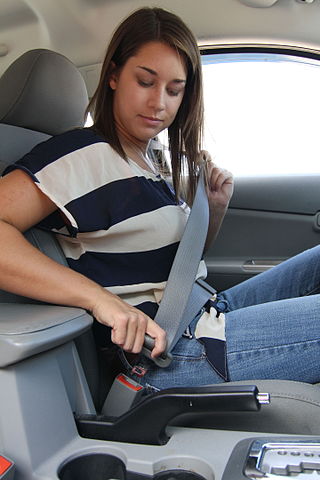
A seat belt, also known as a safety belt or spelled seatbelt, is a vehicle safety device designed to secure the driver or a passenger of a vehicle against harmful movement that may result during a collision or a sudden stop. A seat belt reduces the likelihood of death or serious injury in a traffic collision by reducing the force of secondary impacts with interior strike hazards, by keeping occupants positioned correctly for maximum effectiveness of the airbag, and by preventing occupants being ejected from the vehicle in a crash or if the vehicle rolls over.
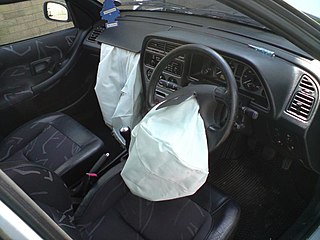
An airbag is a vehicle occupant-restraint system using a bag designed to inflate extremely quickly, then quickly deflate during a collision. It consists of the airbag cushion, a flexible fabric bag, an inflation module, and an impact sensor. The purpose of the airbag is to provide a vehicle occupant with soft cushioning and restraint during a collision. It can reduce injuries between the flailing occupant and the interior of the vehicle.
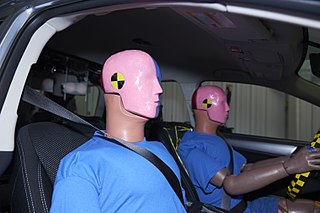
A crash test dummy, or simply dummy, is a full-scale anthropomorphic test device (ATD) that simulates the dimensions, weight proportions and articulation of the human body during a traffic collision. Dummies are used by researchers, automobile and aircraft manufacturers to predict the injuries a person might sustain in a crash. Modern dummies are usually instrumented to record data such as velocity of impact, crushing force, bending, folding, or torque of the body, and deceleration rates during a collision.

Crumple zones, crush zones, or crash zones are a structural safety feature used in vehicles, mainly in automobiles, to increase the time over which a change in velocity occurs from the impact during a collision by a controlled deformation; in recent years, it is also incorporated into trains and railcars.
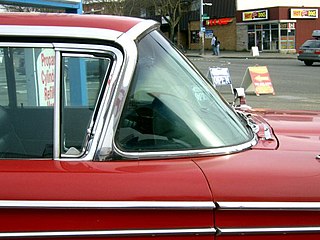
The windshield or windscreen of an aircraft, car, bus, motorbike, truck, train, boat or streetcar is the front window, which provides visibility while protecting occupants from the elements. Modern windshields are generally made of laminated safety glass, a type of treated glass, which consists of, typically, two curved sheets of glass with a plastic layer laminated between them for safety, and bonded into the window frame.

Colonel John Paul Stapp, M.D., Ph.D., was an American career U.S. Air Force officer, flight surgeon, physician, biophysicist, and pioneer in studying the effects of acceleration forces on humans. He was a colleague and contemporary of Chuck Yeager, and became known as "the fastest man on earth". His work on Project Manhigh pioneered many developments for the US space program.

A crash test is a form of destructive testing usually performed in order to ensure safe design standards in crashworthiness and crash compatibility for various modes of transportation or related systems and components.

Automotive safety is the study and practice of automotive design, construction, equipment and regulation to minimize the occurrence and consequences of traffic collisions involving motor vehicles. Road traffic safety more broadly includes roadway design.

A bumper is a structure attached to or integrated with the front and rear ends of a motor vehicle, to absorb impact in a minor collision, ideally minimizing repair costs. Stiff metal bumpers appeared on automobiles as early as 1904 that had a mainly ornamental function. Numerous developments, improvements in materials and technologies, as well as greater focus on functionality for protecting vehicle components and improving safety have changed bumpers over the years. Bumpers ideally minimize height mismatches between vehicles and protect pedestrians from injury. Regulatory measures have been enacted to reduce vehicle repair costs and, more recently, impact on pedestrians.

A side collision is a vehicle crash where the side of one or more vehicles is impacted. These crashes typically occur at intersections, in parking lots, and when two vehicles pass on a multi-lane roadway.

In May 2013 the World Health Organization (WHO) reported that more than 270,000 pedestrians lose their lives on the world’s roads each year, accounting for 22% of the total 1.24 million road traffic deaths. Despite the magnitude of the problem, most attempts at reducing pedestrian deaths had historically focused solely on education and traffic regulation. Since the 1970s, crash engineers have begun to use design principles that have proved successful in protecting car occupants to develop vehicle design concepts that reduce the likelihood of injuries to pedestrians in the event of a car-pedestrian crash, or reduce the likelihood of a car-pedestrian crash in the first place.

An impact attenuator, also known as a crash cushion, crash attenuator, or cowboy cushion, is a device intended to reduce the damage to structures, vehicles, and motorists resulting from a motor vehicle collision. Impact attenuators are designed to absorb the colliding vehicle's kinetic energy. They may also be designed to redirect the vehicle away from the hazard or away from roadway machinery and workers. Impact attenuators are usually placed in front of fixed structures near highways, such as gore points, crash barrier introductions, or overpass supports. Temporary versions may be used for road construction projects.
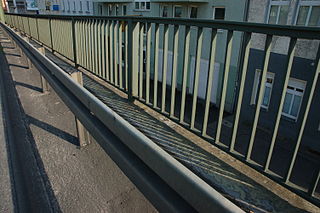
Traffic barriers keep vehicles within their roadway and prevent them from colliding with dangerous obstacles such as boulders, sign supports, trees, bridge abutments, buildings, walls, and large storm drains, or from traversing steep (non-recoverable) slopes or entering deep water. They are also installed within medians of divided highways to prevent errant vehicles from entering the opposing carriageway of traffic and help to reduce head-on collisions. Some of these barriers, designed to be struck from either side, are called median barriers. Traffic barriers can also be used to protect vulnerable areas like school yards, pedestrian zones, and fuel tanks from errant vehicles.

The Sikorsky S-75 was a proof-of-concept all-composite helicopter. Sikorsky Aircraft used all-composite materials to replace metal to provide greater strength, lighter weight, lower manufacturing costs, and reduce maintenance costs.
Hugh DeHaven was an American pilot, engineer and passive safety pioneer. DeHaven survived a plane crash while training as a Royal Canadian Flying Corps pilot during the First World War, and became interested in improving human survivability in vehicle crashes. He has been called "Father of Crash Survivability".
The Dynamic Response Index (DRI) is a measure of the likelihood of spinal damage arising from a vertical shock load such as might be encountered in a military environment. The DRI is a dimensionless number which is proportional to the maximum spinal compression suffered during the event.
The head injury criterion (HIC) is a measure of the likelihood of head injury arising from an impact. The HIC can be used to assess safety related to vehicles, personal protective gear, and sport equipment.
Pam-Crash is a software package from ESI Group used for crash simulation and the design of occupant safety systems, primarily in the automotive industry. The software enables automotive engineers to simulate the performance of a proposed vehicle design and evaluate the potential for injury to occupants in multiple crash scenarios.
Dean L. Sicking is an American inventor and safety researcher.















